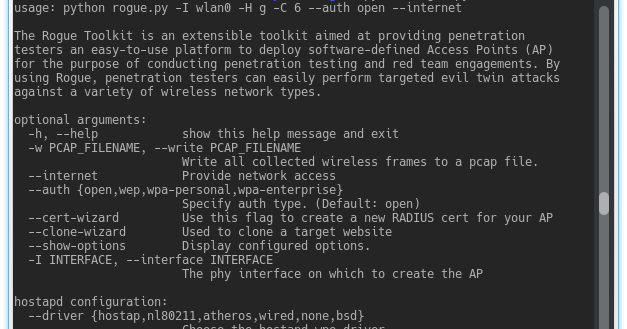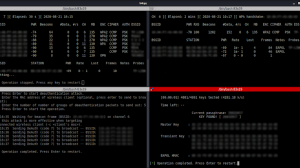- Compromising corporate accounts to be later used in impersonation attacks to gain access to corporate wireless networks.
- To subvert network protections, such as captive portals or client to client isolation, to be able to target and compromise connected wireless devices and using compromised devices and credentials to pivot deeper into internal networks.

Usage
usage: python rogue.py -I wlan0 -H g -C 6 --auth open --internetThe Rogue Toolkit is an extensible toolkit aimed at providing penetration
testers an easy-to-use platform to deploy software-defined Access Points (AP)
for the purpose of conducting penetration testing and red team engagements. By
using Rogue, penetration testers can easily perform targeted evil twin attacks
against a variety of wireless network types.
optional arguments:
-h, –help show this help message and exit
-w PCAP_FILENAME, –write PCAP_FILENAME
Write all collected wireless frames to a pcap file.
–internet Provide network access
–auth {open,wep,wpa-personal,wpa-enterprise}
Specify auth type. (Default: open)
–cert-wizard Use this flag to create a new RADIUS cert for your AP
–clone-wizard Used to clone a target website
–show-options Display configured options.
-I INTERFACE, –interface INTERFACE
The phy interface on which to create the AP
hostapd configuration:
–driver {hostap,nl80211,atheros,wired,none,bsd}
Choose the hostapd-wpe driver
Attack Arguments:
–karma Enable Karma.
–sslsplit Enable sslsplit.
–responder Enable responder using default configuration.
–essid-mask {0,1,2} Send empty SSID in beacons and ignore probe request
frames that do not specify full SSID. 1 = send empty
(length=0) SSID in beacon and ignore probe request for
broadcast SSID 2 = clear SSID (ASCII 0), but keep the
original length (this may be required with some
clients that do not support empty SSID) and ignore
probe requests for broadcast SSID (Default: 0)
–hostile-portal Enable hostile portal.
–hostile-mode {beef,responder}
Select attack type performed by hostile portal.
–hostile-location HOSTILE_LOCATION
Used to specify the location of the cloned site
location. Note: httrack creates a new directory within
the destination location with the name of the site
cloned. (Default: /var/www/html)
–target-file TARGET_FILE
Used to specify the file in which the hostile portal
hook will be inserted into. (Default: /index.html)
–hostile-marker HOSTILE_MARKER
Specify the line in the file target file to insert the
web hook above. (Default: </body> )
–hostile-hook HOSTILE_HOOK
Specify custom hook code to insert into the target
file
IEEE 802.11 related configuration:
-B BSSID, –bssid BSSID
Specify access point BSSID
-E ESSID, –essid ESSID
Specify access point ESSID
-H {a,b,g,n,ac}, –hw-mode {a,b,g,n,ac}
Specify access point hardware mode (Default: g).
–freq {2,5} Specify the radio band to use (Default: 2GHz).
-C CHANNEL, –channel CHANNEL
Specify access point channel. (Default: 0 – with ACS
to find an unused channel)
–country {AU,US} Configures of country of operation
–macaddr-acl {0,1,2}
Station MAC address -based authentication
–auth-algs {1,2,3} IEEE 802.11 specifies two authentication algorithms. 1
allows only WPA2 authentication algorithms. 2 is WEP.
3 allows both.
–wmm-enabled Enable Wireless Multimedia Extensions
–ieee80211d Enabling IEEE 802.11d advertises the country_code and
the set of allowed channels and transmit power levels
based on the regulatory limits. (Default: False)
–ieee80211h Enables radar detection and DFS support. DFS support
is required for an outdoor 5 GHZ channel. (This can
only be used if ieee80211d is enabled). (Default:
False)
–ap-isolate Enable client isolation to prevent low-level bridging
of frames between associated stations in the BSS.
(Default: disabled)
IEEE 802.11n related configuration:
–ht-mode {0,1,2} Configure supported channel width set 0 = Feature
disabled 1 = [HT40-] (2.4 GHz = 5-13, 5 GHz =
40,48,56,64) 2 = [HT40+] (2.4 GHz = 1-7 (1-9 in
Europe/Japan), 5 GHz = 36,44,52,60) (Default = 0).
–disable-short20 Disables Short GI for 20 MHz for HT capabilities.
–disable-short40 Disables Short GI for 40 MHz for HT capabilities.
–require-ht Require stations to support HT PHY (reject association
if they do not). (Default: False)
IEEE 802.11ac related configuration:
–vht-width {0,1,2,3}
VHT channel width (Default: 1).
–vht-seg0_index VHT_OPER_CENTR_FREQ_SEG0_IDX
index 42 gives center freq 5.210 GHz (Default: 42).
–vht-seg1_index VHT_OPER_CENTR_FREQ_SEG1_IDX
index 159 gives center freq 5.795 GHz (Default: 159).
–require-vht Require stations to support VHT PHY (reject
association if they do not) (Default: disabled).
IWPA/IEEE 802.11i configuration:
–wpa-passphrase WPA_PASSPHRASE
Specify the Pre-Shared Key for WPA network.
–wpa {1,2,3} Specify WPA type (Default: 2).
–wpa-pairwise {CCMP,TKIP,CCMP TKIP}
(Default: ‘CCMP TKIP’)
–rsn-pairwise {CCMP,TKIP,CCMP TKIP}
(Default: ‘CCMP’)
WEP authentication configuration:
–wep-key-version {0,1,2,3}
Determine the version of the WEP configuration
–wep-key WEP_KEY Determine the version of the WEP configuration
IEEE 802.1X-2004 configuration:
–ieee8021x Enable 802.1x
–eapol-version {1,2}
IEEE 802.1X/EAPOL version
–eapol-workaround EAPOL-Key index workaround (set bit7) for WinXP
Supplicant
RADIUS client configuration:
–log-badpass logs password if it’s rejected
–log-goodpass logs password if it’s correct
–own-address OWN_IP_ADDR
The own IP address of the access point (Default:
127.0.0.1)
–auth-server-addr AUTH_SERVER_ADDR
IP address of radius authentication server (Default:
127.0.0.1)
–auth-secret AUTH_SERVER_SHARED_SECRET
Radius authentication server shared secret (Default:
secret)
–auth-server-port AUTH_SERVER_PORT
Networking port of radius authentication server
(Default: 1812)
–acct-server-addr ACCT_SERVER_ADDR
IP address of radius accounting server (Default:
127.0.0.1)
–acct-secret ACCT_SERVER_SHARED_SECRET
Radius accounting server shared secret
–acct-server-port ACCT_SERVER_PORT
Networking port of radius accounting server (Default:
1813)
–radius-proto {udp,tcp,*}
(Default: *)
–eap-type {fast,peap,ttls,tls,leap,pwd,md5,gtc}
(Default: md5)
–print-creds Print intercepted credentials
External DHCP configuration:
–lease DEFAULT_LEASE_TIME
Define DHCP lease time (Default: 600)
–max-lease MAX_LEASE_TIME
Define max DHCP lease time (Default: 7200)
–prim-name-server PRIMARY_NAME_SERVER
Define primary name server (Default: 8.8.8.8)
–sec-name-server SECONDARY_NAME_SERVER
Define secondary name server (Default: 8.8.4.4)
–subnet DHCP_SUBNET (Default: 10.254.239.0)
–route-subnet ROUTE_SUBNET
(Default: 10.254.239)
–netmask DHCP_NETMASK
(Default: 255.255.255.0)
–ip-address IP_ADDRESS
(Default: 10.254.239.1)
–secondary-interface SECONDARY_INTERFACE
Used to specify the second phy interface used to
bridge the hostapd-wpe interface (-I) with another
network (Default: eth0)
–pool-start DHCP_POOL_START
(Default: 10.254.239.10)
–pool-end DHCP_POOL_END
(Default: 10.254.239.70)
Website cloning configuration:
–clone-target CLONE_TARGET
Used to specify target website to clone (e.g.
https://www.example.com/)
–clone-dest CLONE_DEST
Specify the location of the web root for the hostile
portal, it is recommended that you clone to your web
root. Note: httrack will create a directory in this
location with the name of the site cloned. (Default:
/var/www/html)
sslsplit configuration:
–cert-nopass Generate a x.509 Certificate with no password for the
purpose of sslsplit.
–encrypted-port SSLSPLIT_ENCRYPTED_PORT
Specify port for encrypted web communication (TCP/443)
be redirected to. (Default: 8443)
HTTPD configuration:
–httpd-port HTTPD_PORT
defines the port for httpd service to listen on.
(Default: 80)
–httpd-ssl-port HTTP_SSL_PORT
Defines port for SSL-enabled httpd service to listen
on. (Default: 443)
–ssl Enable ssl version of rogue httpd. When enabled,
–httpd-ssl-port overwrites –httpd-port. (Default:
443)






















Add Comment